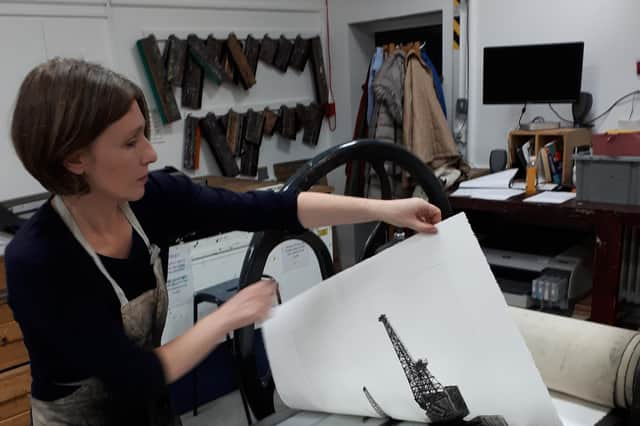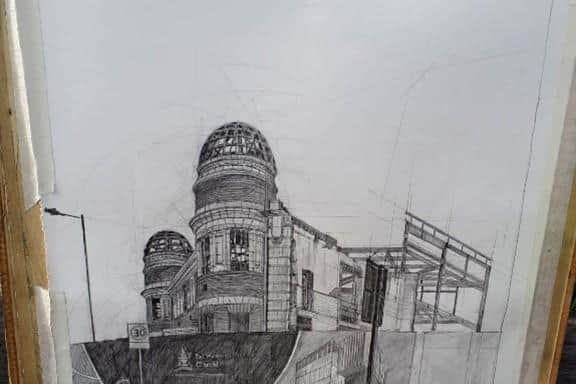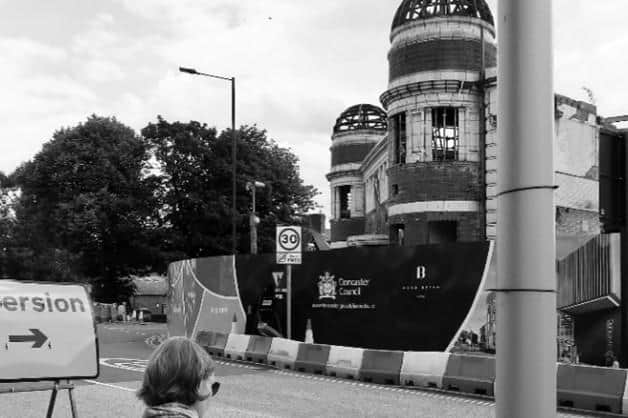Doncaster-born artist and printmaker returns to home town for new exhibition of work alongside fellow artist Sir Frank Brangwyn


It was as an art student that acclaimed artist Melanie Bellis first encountered the work of artist and printmaker Sir Frank Brangwyn – and it left a lasting impression, inspiring her throughout her career. Now the work of both artists has been brought together in a new exhibition, Out of Line, at the Danum Gallery, Library and Museum in Doncaster. The show highlights the connections between the large-scale prints and drawings of Doncaster-born Bellis, who now lives in London, and artworks by Brangwyn held in the collection of Heritage Doncaster.
Born in 1867, Brangwyn was at the forefront of the print revival which began in the 1850s. Although his creative practice also took in painting, murals, illustration and ceramics, he excelled in etching and drypoint and became one of the most influential etchers of the early to mid-20th century. Over the course of his long career – he died in 1956 – Brangwyn produced more than 500 print works.
Advertisement
Hide AdAdvertisement
Hide AdThe exhibition at the Danum Gallery developed out of a visit Bellis made in 2018 to Doncaster – where she grew up, went to school and completed her art foundation course – after she discovered that the city holds a significant collection of Brangwyn’s work.


“They have around 60 of his drawings and prints and I went along to see them stored away in the archives of the museum,” she says. “Afterwards I sent a quick email to the curator to say how much I had enjoyed the collection and we got talking about the connections between Brangwyn’s work and mine. Out of those conversations grew the idea of the show.” The exhibition focuses on the closely linked activities of drawing and printmaking in both artists’ work, their interest in urban, industrialised landscapes, their passion for documenting the essence of an environment and their commitment to printmaking as an art form. Both artists are fellows of the Royal Society of Painter-Printmakers – to which Bellis was elected in 2017 – founded in 1880 by the artist and surgeon Francis Seymour Haden in response to the Royal Academy of Arts’ reluctance to exhibit etchings and engravings.
While working a century apart, Bellis and Brangwyn have, through their work, captured a snapshot of their times, offering fascinating insights into two distinct eras. “I have always been impressed by the scale and ambition of Brangwyn’s etchings and by the freedom and expressive nature of his mark making,” says Bellis. “There is a lot of energy in his work, it’s very gestural. It is also so atmospheric and captures a sense of his time which is something I want to achieve in my own work.”
In her work Bellis explores scenes of derelict and decaying buildings from Britain’s industrial past as well as well-known contemporary buildings and new buildings under construction such as the new American Embassy in Vauxhall, renovations to Big Ben and the extension to the Tate Modern. “I have always drawn – I knew I wanted to be an artist from a very early age – and I was always interested in structures, buildings and industry, the railway industry in particular which is part of Doncaster’s heritage. I like to draw things that are either falling down or being built; I am fascinated by things that are changing or transient.”
Advertisement
Hide AdAdvertisement
Hide AdBellis begins all her work on site in the open air, in locations that she has chosen on one of her frequent field trips exploring city streets and urban landscapes. “My work always starts with me sitting and drawing on site – I sit there for hours starting with sketches, trying out different compositions in my sketchbooks, then doing detailed drawings and really absorbing the sense of the place. It is about my experience of it, and I feel like I am trying to capture a point in time; certainly, with the work I have done on various buildings around London, they form almost a visual diary of how things are changing in the city.” After her detailed on-site drawings, the next stage is to create the etchings, using a traditional printmaking technique which has remained virtually unchanged for around 500 years. “The process of etching is central to my work, it feels like a natural progression from my drawings and a way of developing and transforming my images,” says Bellis. “With etching, you are creating a line that is deeper and has more impact than in drawing. I have been etching for over 30 years and what I loved about it the first time I did it was that you could take your drawing forward and give it more intensity and atmosphere. I have tried other printmaking techniques but I always come back to etching – I think you are always learning and experimenting. It fascinates me still.”


The show is curated and hung in such a way that the work of Bellis and Brangwyn are combined, not separated, allowing the viewer to see the links between the two in terms of subject matter and approach. There are large-scale drawings of the railways around Doncaster which Bellis made especially for the exhibition from sketches she did during lockdown. It is a subject to which she will return in future projects. “I am thinking about doing some more railway drawings around Doncaster,” she says. “I am also looking at various old warehouses and power stations around London – I am really drawn to Victorian utility buildings at the moment.”
Brangwyn’s connection with Doncaster was through his friendship with Father Jerome Esser who was parish priest in Stainforth from 1931 until his death in 1948. Esser was also an artist and had learnt techniques from Brangwyn. It was through this friendship that in 1944 Brangwyn donated to Doncaster the works held in the city’s collection. “He was incredibly generous with his work. He produced so much, and he was very supportive of other artists, especially helping those who had fallen on hard times,” says Bellis. “He did retreat from the art world a bit towards the end of his life – he was very well known during his lifetime but is less so these days.”
She hopes that the exhibition will bring Brangwyn’s work to the attention of today’s audiences. “It is just a snapshot of his work really – he was so prolific, but there is quite a lot of information about him in the show so people can understand what he accomplished. And for me it is such a great privilege to display my work alongside an artist whose work has inspired me for so long.”
Out of Line, drawings and prints by Sir Frank Brangwyn and Melanie Bellis, runs at the Danum Gallery, Library and Museum, Doncaster, until July 9.